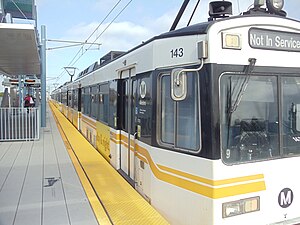Culver City station
Culver City | ||||||||||||||||||||||||||||||||||||
|---|---|---|---|---|---|---|---|---|---|---|---|---|---|---|---|---|---|---|---|---|---|---|---|---|---|---|---|---|---|---|---|---|---|---|---|---|
 Expo Line train at Culver City Station. | ||||||||||||||||||||||||||||||||||||
| General information | ||||||||||||||||||||||||||||||||||||
| Location | 8817 Washington Blvd Culver City CA 90232 | |||||||||||||||||||||||||||||||||||
| Owned by | Metro | |||||||||||||||||||||||||||||||||||
| Platforms | 1 center platform | |||||||||||||||||||||||||||||||||||
| Tracks | 2 | |||||||||||||||||||||||||||||||||||
| Connections | Metro Local: 33, 220 Metro Express: 534 Metro Rapid: 733 Culver CityBus: 1, 5, 7 Santa Monica Big Blue Bus: 5, 12, Rapid 12, Rapid 20 | |||||||||||||||||||||||||||||||||||
| Construction | ||||||||||||||||||||||||||||||||||||
| Parking | 586 spaces | |||||||||||||||||||||||||||||||||||
| Bicycle facilities | 8 bike racks 16 bike lockers | |||||||||||||||||||||||||||||||||||
| Accessible | Yes | |||||||||||||||||||||||||||||||||||
| Other information | ||||||||||||||||||||||||||||||||||||
| Status | in service | |||||||||||||||||||||||||||||||||||
| History | ||||||||||||||||||||||||||||||||||||
| Opened | October 17, 1875 | |||||||||||||||||||||||||||||||||||
| Rebuilt | June 20, 2012[1] | |||||||||||||||||||||||||||||||||||
| Previous names | Culver Junction; Ivy | |||||||||||||||||||||||||||||||||||
| Services | ||||||||||||||||||||||||||||||||||||
| ||||||||||||||||||||||||||||||||||||
Culver City (formerly Culver Junction and Ivy) station is an elevated light rail station in the Los Angeles Metro system located at the northeast edge of Downtown Culver City. A rail station since the 1800s, it is now served by the Expo Line and is the line's temporary western terminus until Expo Phase 2 to Santa Monica is completed.[2]
Metro Rail service
Expo Line service hours are approximately from 4 AM to 12:30 AM daily. Regular scheduled service resumed June 20, 2012.
Location and design
| Eastbound | ■ Expo Line | toward 7th Street/Metro Center (La Cienega/Jefferson) |
| Eastbound | ■ Expo Line | toward 7th Street/Metro Center (La Cienega/Jefferson) |
The station is located in Downtown Culver City on a dedicated rail right-of-way alongside Exposition Boulevard — between the intersection of Venice Boulevard and Robertson Boulevard on the west, and the intersection of Washington Boulevard and National Boulevard on the east.
Attractions
At the northeast edge of Downtown Culver City, a major retail, entertainment and arts district, the station is also within walking distance of several major attractions which include the
- Hayden Tract
- Museum of Jurassic Technology
- Kirk Douglas Theater
- Ivy Substation (a former power building for this station)
The station's art consists of images from which concentric lines expand outwards like rings on a tree and was created by artist Tom LaDuke.[3]
History


Originally named Ivy station on the steam powered Los Angeles and Independence Railroad, Pacific Electric later renamed it Culver Junction in the early 1900s when the stop was made a junction point with the addition of the Venice short line and others which continued west down Venice Boulevard to the South Bay.
While the Venice line closed in September, 1950, making it no longer a junction, and station was closed along with the Air line on September 30, 1953, the name "Culver Junction" remains on maps to this day, referring to the immediate surrounding area. With service restoration in June 2012, the station was renamed Culver City.
Ivy Substation, a traction substation building which housed mechanical rotary converters used to supply DC current to the line until 1953, is still standing near this station and has been converted into the popular Actor's Gang Theatre. (Train power now comes from a much smaller building beneath the elevated platform.)
References
- Electric Railway Historical Association of Southern California, Pacific Electric, accessed January 2008
- Electric Railway Historical Association of Southern California, A Chronology of Changes in Rail Passenger Operations of the Pacific Electric Railway Company, accessed January 2008
- Line names mostly come from the McGraw Transit Directory, 1920, p. 11.
